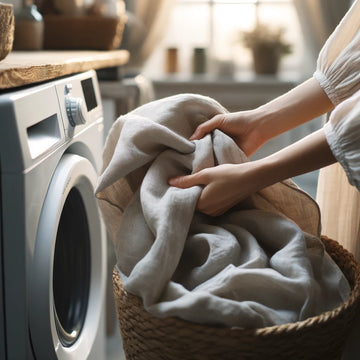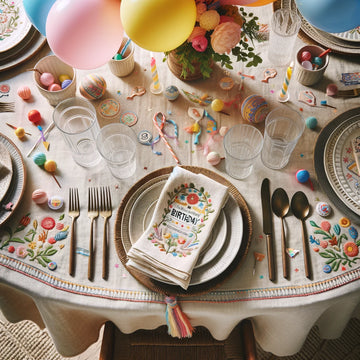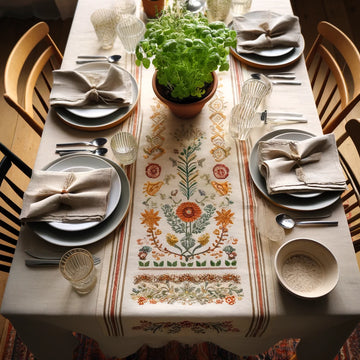Drying 100% Linen: Best Practices for Your Linens
When it comes to caring for your 100% linen items, drying is a crucial step in maintaining their quality and longevity. At Blue Flower Co., we understand the importance of proper linen care, and we're here to share our expert tips on drying your linen tablecloths, napkins, and other household linens.
Can 100% Linen Go in the Dryer?
One of the most common questions we receive is whether 100% linen can go in the dryer. The answer is yes, but with some important considerations. While linen is a durable and resilient fabric, it can shrink or lose its shape if exposed to high heat. To minimize the risk of damage, it's best to use low heat settings or opt for air drying when possible.
The Best Methods for Drying 100% Linen Fabrics
Air Drying Linen
Air drying is the most gentle method for drying 100% linen fabrics. To air dry your linens, simply hang them on a clothesline or lay them flat on a clean, dry surface. Avoid direct sunlight, as it can cause fading and weaken the fibers over time. Our Linen Tablecloth With Dragonfly Embroidery in Natural is a perfect candidate for air drying, as it helps preserve the delicate embroidery.

Machine Drying Linen
If you choose to machine dry your 100% linen items, be sure to use the lowest heat setting possible. High heat can cause shrinkage and damage to the fibers. Remove your linens from the dryer while they are still slightly damp to minimize wrinkling. Our Linen Napkins With Lace Ends in Old English Green can be machine dried on low heat, but be sure to remove them promptly to maintain their shape and texture.

The Effects of Machine Drying on Linen Fibers
While machine drying can be convenient, it's important to understand the potential effects on your linen fibers. High heat and prolonged exposure to tumbling can weaken the fibers over time, leading to shrinkage, loss of shape, and reduced longevity. To minimize these effects, always use the lowest heat setting and remove your linens promptly.
| Drying Method | Pros | Cons |
|---|---|---|
| Air Drying | Gentle on fibers, minimizes shrinkage | Takes longer, requires space |
| Machine Drying (Low Heat) | Faster, convenient | Can cause shrinkage and damage if not monitored |
| Machine Drying (High Heat) | Fastest | Causes significant shrinkage and damage, not recommended |
Tips for Maintaining the Quality and Longevity of Linen When Drying
To ensure your 100% linen items stay beautiful and last for years to come, follow these tips when drying:
- Always check the care label for specific drying instructions.
- Opt for air drying whenever possible, especially for delicate or embroidered items like our Linen Table Runner With Overlaid Lace in Brown.
- If machine drying, use the lowest heat setting and remove items promptly.
- Avoid overstuffing the dryer, as this can lead to excessive wrinkling and tangling.
- Fold or hang your linens immediately after drying to minimize wrinkling.

Specific Care Instructions for Various Linen Items
Drying Linen Tablecloths
When drying your linen tablecloths, it's best to air dry them whenever possible. If you must use a dryer, use the lowest heat setting and remove the tablecloth while it is still slightly damp. Hang or lay flat to finish drying, and iron if desired for a crisp, polished look. Our Linen Tablecloth with Botanical Embroidery in Beige is a stunning example of a tablecloth that benefits from gentle drying techniques.

Drying Linen Napkins
Linen napkins, like our Colored Marrow 100% Linen Napkins in White Base, can be air dried or machine dried on low heat. If machine drying, remove the napkins while they are still slightly damp and fold or press immediately to minimize wrinkling. For a polished look, consider ironing your linen napkins before use.

Drying Linen Kitchen Towels
Linen kitchen towels, like our Linen Kitchen Towel in Beige and Linen Kitchen Towel in Blue, are often subjected to frequent use and washing. To ensure their longevity, air dry them whenever possible or machine dry on low heat. Remove them from the dryer while slightly damp and hang or fold immediately to minimize wrinkling.


Drying Linen Bedding
When drying your linen bedding, such as pillowcases like our White Linen Scalloped Pillow Cover, opt for air drying or machine drying on low heat. Remove the items from the dryer while they are still slightly damp and hang or lay flat to finish drying. This will help minimize wrinkling and maintain the shape of your linen bedding.

Drying Linen Aprons
Linen aprons, like our Embroidered Linen Apron and Linen Apron in Soft Pink, can be air dried or machine dried on low heat. If machine drying, remove the apron from the dryer while it is still slightly damp and hang or lay flat to finish drying. This will help preserve the shape and any decorative elements, such as embroidery or lace.


Linen Care Instructions
In addition to drying, there are several other important factors to consider when caring for your 100% linen items:
Washing Linen
Always check the care label for specific washing instructions. Most linen items can be machine washed on a gentle cycle using cold or lukewarm water and a mild detergent. Avoid using bleach or fabric softeners, as these can weaken the fibers and cause discoloration.
Storing Linen
To keep your linen items looking their best, store them in a cool, dry place away from direct sunlight. Avoid storing linen in plastic bags, as this can trap moisture and lead to mildew or yellowing. Instead, use breathable cotton storage bags or line your storage shelves with acid-free tissue paper.
Ironing Linen
If desired, you can iron your linen items to achieve a crisp, polished look. Use a medium-hot iron and always iron on the reverse side of the fabric to avoid any potential damage to the fibers or decorative elements. For items with embroidery or lace, like our Linen Table Runner With Inlaid Lace in Pink, use a press cloth to protect the delicate areas.

Conclusion
Proper drying techniques are essential for maintaining the quality and longevity of your 100% linen items. By following the best practices outlined in this guide, you can ensure that your linen tablecloths, napkins, kitchen towels, bedding, and aprons stay beautiful and functional for years to come.
At Blue Flower Co., we are dedicated to providing our customers with high-quality linen products and the knowledge to care for them properly. Browse our collections of linen tablecloths, linen napkins, linen table runners, and other linen essentials to find the perfect additions to your home.







